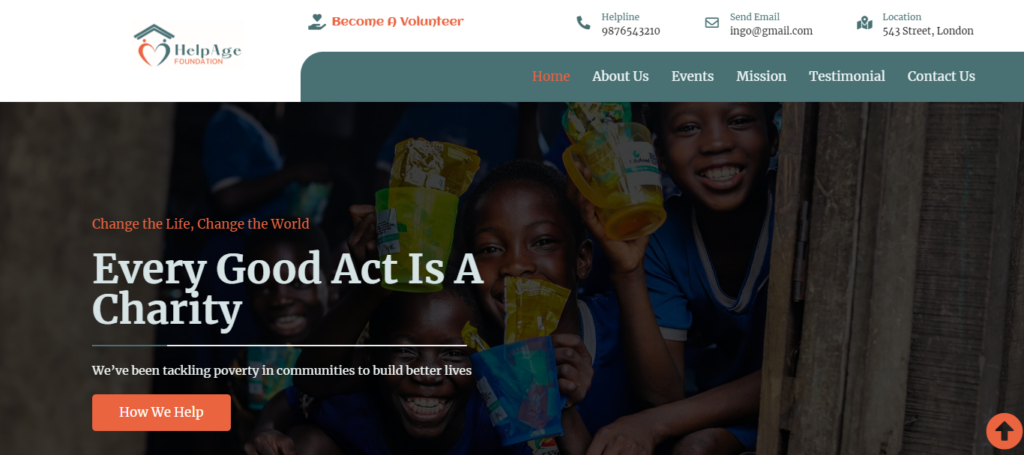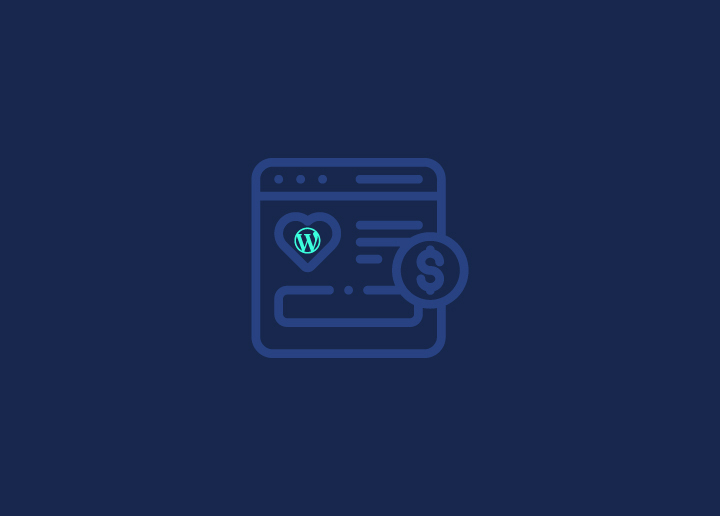Want to build a website for your nonprofit organization? Look no further than WordPress! Whether you’re a budding nonprofit or a well-established NGO, WordPress offers unparalleled flexibility, accessibility, and innovation in website development.
Its open-source nature, coupled with an extensive array of themes & plugins, makes it a powerful tool for crafting different types of websites. In this guide, we’ll walk you through six simple steps to building a WordPress website for your nonprofit, helping you increase awareness and engagement for your cause.
Contents
TogglePrerequisites for Building a Nonprofit Organization Website
Before moving to the steps of building a website for your nonprofit organization, here are two crucial prerequisites that you need to address:
Identify and Define the Goals of Your Nonprofit Organization
Understanding the goals and objectives of your nonprofit organization is fundamental to developing a successful website.

Firstly, consider your nonprofit’s purpose. What social or environmental issues are you addressing? What specific change or impact do you aim to achieve? This clarity will guide the development of your website’s content and design elements.
Next, break down your goals into specific, achievable objectives. These could include increasing donations, recruiting volunteers, raising awareness about your cause, or providing resources and support to your target audience.
Furthermore, consider your target audience and stakeholders. What are their needs, preferences, and behaviors? This will help you tailor your website’s features and messaging to resonate with them and encourage engagement from your audience.
Learn: WordPress for Nonprofit: Amplifying Your Online Voice
Want to Make a Real Impact with Your Nonprofit Website?
Let us help you build a custom website that showcases your mission and connects you with donors. Reach out now.
Choose a Domain Name and Hosting Provider
Selecting a domain and hosting provider is critical in laying the foundation for your nonprofit organization’s website.

Your domain name (website’s name) serves as your digital identity, representing your organization and making it easily accessible to your audience. When selecting a domain name, aim for something that is memorable, relevant to your cause, and reflects your organization’s identity.
Equally important is choosing the right hosting provider so your website remains accessible, secure, and performs optimally. Consider reputable hosting providers such as:
Evaluate the hosting provider’s uptime guarantee and server response times to ensure your website remains accessible to visitors at all times. Also, compare factors such as pricing, performance, reliability, security features, and customer support to make an informed decision.
Steps to Build a WordPress Website for Nonprofit Organization
Now that we’ve addressed the prerequisites, let’s explore the steps to build a WordPress website for a nonprofit organization.
Step 1: Install WordPress
Begin by installing WordPress on your hosting account, either through a one-click installer or a manual installation process.
Step 2: Choose a WordPress Theme
Select a suitable WordPress theme that aligns with your nonprofit organization’s branding and mission. Here are some nonprofit WordPress themes:

Charity Life WordPress Theme
This theme has a professional design suitable for various nonprofit organizations. Its customizable features and layout options allow you to tailor the theme to fit your organization’s needs.
Nonprofit Organization Free WordPress Theme
As a free option on the WordPress theme directory, this theme provides a simple yet elegant design that is perfect for small nonprofits or those on a budget. It offers essential features to showcase your organization’s work and encourage donations or volunteer participation.
Animal NGO WordPress Theme
If your nonprofit focuses on animal welfare or conservation, this theme provides a visually appealing design tailored to organizations in this sector. It offers features such as pet adoption listings, event calendars, and donation forms to support your cause.
Alone – Charity Multipurpose Nonprofit WordPress Theme
This multipurpose premium theme is ideal for larger nonprofits with diverse programs and initiatives. It offers advanced customization options, integrated donation systems, and compatibility with popular plugins for added functionality.
HelpAge Foundation WordPress Theme
Designed specifically for organizations supporting elderly individuals, this theme features a user-friendly interface, event management tools, and donation-tracking capabilities to support your organization’s mission.
Born To Give – WordPress Crowdfunding Theme
If your nonprofit relies on crowdfunding or peer-to-peer fundraising, this theme provides the functionality you need to launch and manage fundraising campaigns. It offers campaign creation tools, progress tracking, and donor management.
Wonderfund – SeaCare WordPress Theme
This theme is ideal for nonprofits focused on children and older people. It offers a simple yet striking design with features such as project showcases, volunteer registration forms, and donation widgets to support your cause.
Step 3: Customize Your Website
Personalize your website by adjusting colors, fonts, layout, and other design elements to reflect your organization’s identity.
- Start by selecting a color scheme that matches your organization’s branding guidelines, whether it’s warmth and compassion for a humanitarian organization or freshness & vitality for an environmental cause.
- Select fonts that are easy to read and complement your branding style, ensuring consistency across all pages.
- Next, consider the layout and design elements of your website. Arrange content strategically to highlight your organization’s mission, programs, impact, and calls to action. Utilize features such as headers, footers, sidebars, and navigation menus to create a user-friendly browsing experience.
- Also, add images, videos, and graphics to enhance storytelling and captivate your audience. Use high-quality visuals to showcase your nonprofit’s work in action.
Leverage customization options provided by your WordPress theme, such as custom widgets, page templates, and theme settings, to further personalize your website and optimize its performance.
Step 4: Add Content and Create Essential Pages
Here are some essential pages that every nonprofit website should have:
- Home Page: Include a brief overview of your mission, impactful images or videos, and clear calls to action on the home page to direct visitors to explore further.
- About Us: Provide an in-depth look at your nonprofit’s history, mission, values, and team members.
- Programs/Services: Provide details on the specific programs, initiatives, or services your nonprofit offers to address the issue or cause you’re passionate about.
- Impact/Success Stories: Use testimonials, case studies, and statistics to demonstrate the real-world difference your organization is making.
- Get Involved/Donate: Make it easy for visitors to support your cause by providing clear CTA options for volunteering, donating, fundraising, or becoming a member.
- Events/Calendar: Showcase upcoming events, fundraisers, workshops, or community outreach activities on your website.
- Blog/News: Create blogs and share updates, news, insights, and relevant content related to your cause or industry.
- Contact Us: Make it simple for visitors to contact you with questions, inquiries, or partnership opportunities. Provide multiple methods like a contact form, email address, phone number, and social media links.
- Privacy Policy and Terms of Use: Outline your organization’s privacy practices and terms of use to comply with legal requirements and build trust with visitors.
Step 5: Install Essential Plugins
Once your WordPress website is set up and customized, it’s time to enhance its functionality by installing essential nonprofit plugins. Here are some top plugins to consider:
- WPForms: The WPForms plugin helps simplify the process of creating contact forms, donation forms, volunteer sign-up forms, and more.
- WP Charitable: Transform your website into a powerful fundraising platform with WP Charitable. This plugin enables you to create donation campaigns, track fundraising progress, and manage donor information seamlessly.
- WP Simple Pay: WP Simple Pay offers a simple and secure solution for processing payments through Stripe.
- Donorbox: The Donorbox plugin allows you to create customizable donation forms, track donor information, and automate donor communication.
- Donation Thermometer: The Donation Thermometer plugin makes it easy to visually represent fundraising goals and progress on your website.
- OptinMonster: The OptinMonster plugin enables you to create eye-catching pop-ups, slide-ins, and other opt-in forms to capture leads and encourage sign-ups for newsletters or updates.
- All in One SEO: All in One SEO plugin provides tools for optimizing your content, meta tags, and site structure.
- MonsterInsights: MonsterInsights plugin integrates Google Analytics seamlessly into your WordPress site, providing detailed analytics reports.
- Shared Counts: The Shared Counts plugin makes adding social sharing buttons to your website easy.
Step 6: Launch and Promote Your Website
Once your website is ready, launch it to the public. Next, promote your nonprofit website to ensure it reaches your target audience. Here’s how:

- Social Media: Use social media platforms like X (formerly Twitter), Facebook, Instagram, and LinkedIn to promote your website and engage with your audience. Share compelling content, updates, success stories, and calls to action to encourage followers to visit your website and get involved.
- Email Marketing: Build and nurture relationships with your audience through email marketing campaigns. Use your email list to send updates, newsletters, event invitations, and donation appeals.
- Partnerships and Collaborations: Collaborate with other nonprofit organizations, businesses, influencers, and community groups to expand your reach and promote your website.
Read: What is a Blog Hop and How Does it Work
- Online Communities and Forums: Engage with online communities, forums, and discussion groups relevant to your cause or industry. Participate in discussions, share resources, and subtly promote your website where appropriate.
- Press Releases (PR): Write and distribute PR to local newspapers and online media outlets to announce the launch of your website.
- Paid Advertising: Invest in paid online advertising such as Google Ads, Facebook Ads, or sponsored content to reach a targeted audience and drive traffic to your website.
Also read: Ways to Increase Your Bottom of the Funnel Conversions
Cost of a Professional WordPress Website for Nonprofit Organization
Although WordPress allows for free website building, here is a cost breakdown for hiring a professional WordPress agency to develop a website for your nonprofit organization.
| Aspect | Cost | Description |
| Domain Name | $10 – $20 per year | The annual fee for registering a domain name (e.g., yournonprofit.org). Costs may vary depending on the domain registrar and the chosen domain extension (.org, .com, .net, etc.). |
| Web Hosting | $3 – $30 per month | The monthly fee for hosting your website on a server. Costs vary based on the hosting provider, the type of hosting plan (shared, VPS, dedicated), and the features included (storage space, bandwidth, SSL certificate, etc.). |
| WordPress Theme | $0 – $100+ (one-time fee) | While many free nonprofit themes are available, premium themes often offer more features, customization options, and support. |
| Website Design and Development | $0 – $5,000+ (one-time fee) | The cost of hiring a web designer or WordPress developer to customize the WordPress theme, create custom graphics, and build additional features or functionality. |
| Plugins and Add-ons | $0 – $500+ (one-time or annual) | While many plugins are free, some premium plugins may require a one-time or annual fee for access to advanced features or support. |
| Content Creation | $0 – $1,000+ (one-time fee) | Costs may vary depending on whether you create content in-house or hire freelancers or agencies to assist with content creation and editing. |
| Maintenance and Updates | $0 – $100+ per month | Costs may vary depending on whether you handle maintenance tasks yourself or hire a website maintenance service provider. |
| Marketing and Promotion | $0 – $500+ per month | The cost of promoting your website through various channels such as social media, email marketing, search engine optimization (SEO), and online advertising. |
Note: The above costs are estimates and can vary based on various factors. In addition, some costs may be one-time expenses, while others may be ongoing. It’s important for nonprofits to carefully budget and prioritize expenses to ensure they get the most value from their website.
Nonprofit Website: Other Important Considerations
By addressing these important considerations, you can create a nonprofit website that effectively communicates your mission and engages your audience while prioritizing accessibility, search engine visibility, and user experience.

- Responsive Design: Ensure your nonprofit website is responsive across various devices and screen sizes. This is essential as a mobile responsive website provides users with a seamless experience while accessing your site on desktops, laptops, tablets, and smartphones. A responsive design also improves accessibility and usability, leading to higher engagement and retention rates.
- Website Accessibility and Compliance: Adhere to accessibility standards such as WCAG and make your website accessible to all users. Implement features like alternative text for images, keyboard navigation, and clear headings to enhance usability for all visitors.
- Search Engine Optimization (SEO): Optimize your site to improve its visibility and ranking in SERPs. While the AIOSEO plugin can help with optimization, consider investing in professional SEO services for long-term success.
Know more: Why we Switched to AIOSEO from Yoast
- Website Speed: Ensure your website loads swiftly and performs efficiently to provide a positive user experience and reduce bounce rates. Again, while many WordPress speed optimization plugins are available, consider hiring a professional for site optimization services to ensure consistent website performance.
Learn more about: Ultimate Guide For WordPress Speed Optimization
In Conclusion
Building a WordPress website for your nonprofit organization opens up possibilities for amplifying your impact and reaching a wider audience. By following the steps outlined in this guide, you can create a nonprofit website that effectively communicates your mission, engages supporters, and drives meaningful action.
However, for those seeking a truly professional website, hiring an experienced WordPress agency like Seahawk is vital. Our expertise and proficiency ensure your website not only meets but exceeds industry standards for design, functionality, and user experience. Also, by partnering with us, your nonprofit can harness the full potential of WordPress to make a lasting difference in the world.

















